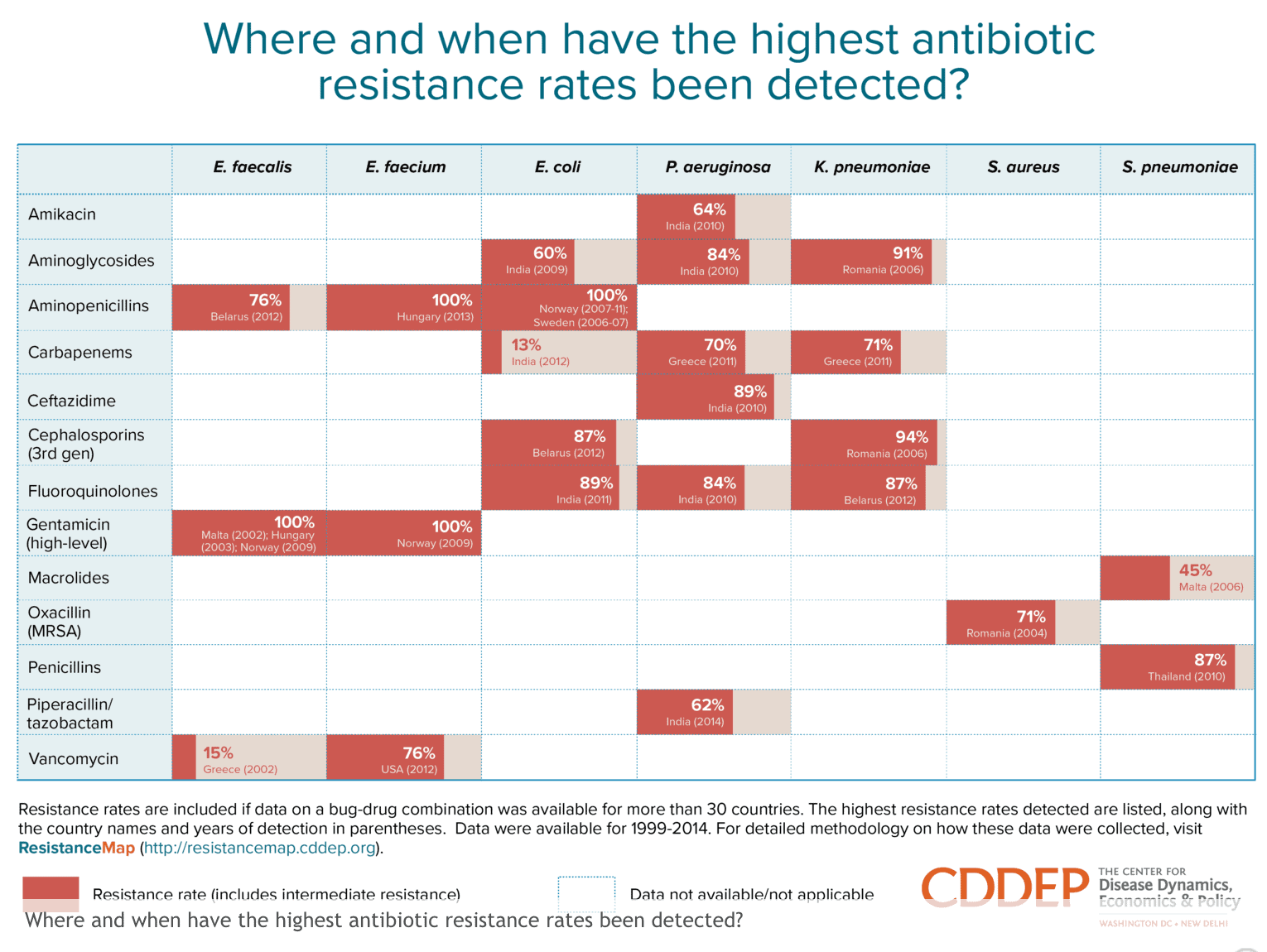March 18, 2016

A weekly roundup of news on drug resistance and other topics in global health.
One health: from buzzword to public practice in Nepal. CDDEP Senior Research Analyst Molly Miller-Petrie wrote about CDDEP researchers’ recent weeklong trip to Nepal, exploring ways the GARP-Nepal Working Group brings together in-country experts on human and veterinary health to address antibiotic resistance. [CDDEP]
Graphic: Where and when have the highest antibiotic resistance rates been detected? A new graphic on the CDDEP website takes data from CDDEP’s ResistanceMap to display the time and place that the highest rates of resistance have been recorded for a variety of antibiotic-pathogen combinations. [CDDEP]
The March issue of GARPNet News, the newsletter of the Global Antibiotic Resistance Partnership, is now available online. The issue features GARP participation at the 17th International Congress for Infectious Diseases (ICID), held in Hyderabad, India March 2–5. Sign up to receive the bi-monthly newsletter here. [CDDEP]
In a small study, an experimental dengue vaccine provided 100 percent protection. The double-blind randomized study, reported in Science Translational Medicine, assigned 41 volunteers to either the vaccine or a placebo, then exposed all 41 to a mild form of dengue six months later. All 20 in the placebo group showed signs of infection—such as rashes or low white blood cell count—while none of the 21 in the vaccine group did. Writes the Washington Post, “researchers—who tend to pepper their description of studies with talk of limitations and caveats—were uncharacteristically optimistic that the vaccine will be successful.” [Washington Post, Science Translational Medicine]
Urinary tract infections (UTIs) in children around the world are highly resistant to common antibiotics, such as ampicillin, with significantly higher rates in lower income countries. In a review of 58 studies from 26 countries, researchers from Bristol University and Imperial College London examined resistance of E. coli isolates from pediatric UTIs to a variety of antibiotics, including ampicillin, trimethoprim, co-amoxiclav, ciprofloxacin and nitrofurantoin. They grouped the results separately for Organization for Economic Cooperation and Development (OECD) countries and non-OECD countries. Resistance to ampicillin was highest among all antibiotics in both groups, with a 53 percent pooled prevalence of resistance in OECD countries and 80 percent in non-OECD countries. Resistance rates were consistently higher—in some cases much higher—in non-OECD countries. [The Guardian, BMJ]
Low vaccination rates—caused by parents refusing to vaccinate their children—contributed to the Disneyland measles outbreak in early 2015, according to research published in JAMA Pediatrics. The analysis found that for the California outbreak to have reached the levels it did, no more than 86 percent of individuals exposed to measles during the outbreak could have been vaccinated. Previous research has found that at least 95 percent coverage is needed to maintain “herd immunity” to the infection. Based on 18 studies examining over 1400 U.S. cases of measles since 2000, researchers concluded that the majority of the outbreaks were sparked by unvaccinated children. The study also analyzed 32 studies on increased whooping cough infections in the United States, and found that both vaccination refusals and declining efficacy of the vaccine were to blame. [Vox, Los Angeles Times, JAMA Pediatrics]
Indian authorities have banned the use and promotion of cefixime-azithromycin, along with 343 other drug combinations. Cefixime–azithromycin is currently marketed by in India by Abbott Pharmaceuticals, a U.S. company, without approval by the central government. The combination is not approved by the U.S. Food and Drug Administration or regulatory authorities in the United Kingdom, Germany, France and Japan. Abbott is the largest company that markets the drug, under their brand name Zimnic AZ, but 15 other companies sell the same combination in India. The Indian government passed a similar ban on fixed-combination drugs (FDCs) in 2007, but a lack of enforcement has led to few changes in sales of such drugs. [Reuters]
About 1 percent of children born to pregnant women infected with Zika virus will develop microcephaly. A study published in The Lancet examined the link between Zika infection and microcephaly across French Polynesia between 2013 and 2015, and found that around 1 in 100 women infected with the virus in their first trimester of pregnancy will have a child with the birth defect. Another study, in PLOS Currents Outbreaks, examined the possible threat of Zika infection across the United States, estimating risk in U.S. cities and metropolitan areas. The accompanying map takes into account the presence of Aedes aegypti mosquitoes, the amount of international travel into and out of an area, and the prevalence of infection with dengue and chikungunya—two viruses that are spread in a similar manner to Zika. [The New York Times, The Lancet, PLOS Currents Outbreaks]
Want to share interesting news via the digest? Email [email protected]











